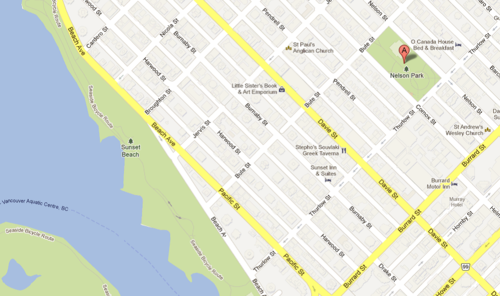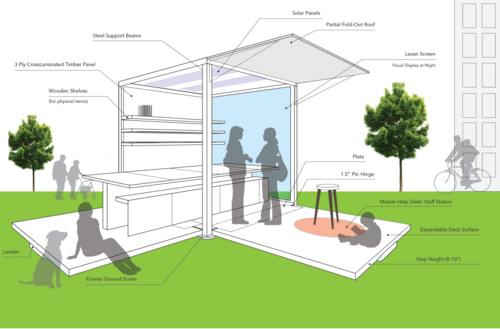The City Living Room: Connection and the City
by Katie Mah
Katie recently launched Library on the Street, (a pilot project for the City Living Room) at the West End Farmer’s Market. It’s a partnership between Katie and Vancouver Public Library, generously funded by Libraries and Literacy and a Vancouver Foundation Small Neighbourhood Grant from Gordon Neighbourhood House. It started late September and will continue through the Winter. For more information, check outwww.facebook.com/libraryonthestreet
Abstract
This paper presents a concept for a mobile satellite library designed to solve two key problems libraries face today:
1. How to present or store digital collections in combination with books.
2. How to re-envision the librarian’s role in light of the Internet and the democratization of publishing. The paper recounts key elements of my design process including research, expert interviews, surveys, systems thinking and prototyping, and lays out future possibilities.
Introduction
The public library is in flux. It’s not just about books anymore. The library is changing from a product to a service model.[1] As William J. Mitchell puts it, digital technology has “dramatically transformed conditions for the reproduction and transmission of information.”[2] Bookshelves may have been sufficient for storing and displaying books in the past, but growing collections and the advent of digital media, such as e-books, are forcing libraries to adapt very quickly.[3] From the card catalogue to the online catalogue, organization and search-ability have been greatly improved; however, many current systems are still linear.[4] Libraries face another problem—a decline in youth attendance.[5] Youth have grown up with the idea of being creators. They want to participate.[6] Web-based creative outlets, such as YouTube, encourage active roles, but interaction at the library is still largely passive. At the same time, there is personal isolation in many cities and communities. One key growth area for libraries is as a third place—third place being public places on neutral ground for informal community interaction.[7] How can we re-inspire our communities? How can we reconnect them?
Thesis Statement
The public library is in transition. What is the role of a physical library in a world where access to information is constant and mobile? What is the librarian’s role when there is too much information?[8] What is the role of a librarian in a world of democratized publishing?[9] How can we combine curation with public input in a digital and physical setting? How can I explore these questions through a satellite library that is an alternate library space in the West End of Vancouver?
Research
I placed my project in the West End of Vancouver because the West End is one of the most population dense neighbourhoods in North America with one of the smallest libraries in the Vancouver Public Library system. Residents use two libraries: the Vancouver Central Library and Joe Fortes Library in the West End itself, but both the Vancouver Public Library and the City of Vancouver’s Planning department acknowledge that even this is inadequate.[10]
I spoke to thought leaders of the International Federation of Library Associations in several countries, including Denmark and the Netherlands, to architects designing libraries, to Vancouver Public Library senior staff, to university librarians, and to interaction design researcher Kirralie Houghton in Australia. They told me that libraries need to reach out to people in ways that are relevant to their daily lives; that to solve any of the current problems we have to look to the future; and that we need to connect digital and physical sources of information.[11] The Vancouver Public Library technology and resources director told me that mobility and access are key issues.[12] They told me libraries are responding to change by exploring play, way-finding, and social space.[13] In fact, many libraries in the Western developed world are reducing library collections in favor of social space.[14] Many libraries in the U.S. are adopting the Makerspace model and providing 3D printers, cameras, programs, and mentoring for people to create their own material.[15] Libraries are valuable not only for their academic ambience, but as a “forum for engagement with others, and a flexible space.”[16] In the Seattle Library, the Mixing Chamber located between the virtual and physical collections functions as a communication hub between librarians and users, “with skilled support on hand and a wealth of information sources available”.[17] I attended a number of workshops and conferences in which I learned about library innovation and creating public spaces, and in one workshop I developed a business plan for my idea of a satellite library. I approached and have been fortunate enough to gain the support of the Vancouver Public Library and the City of Vancouver’s West End Community Planning Team. My project has received a grant from the Vancouver Foundation.
Public Space and Libraries
Libraries are trying to meet people in the stream of daily life. As Nancy Courtney puts it, “the focus is shifting away from the traditional library as place and toward a more ubiquitous presence”.[18] This has resulted in the emergence of pop-up libraries all over the world, from Sweden to Germany to the United States. Pop-up libraries are outdoor bookshelves located on private or public property, which are open to the public and arranged by the public. Some pop-up libraries include programming, such as New York’s Uni Project, a modular library-based intervention which has been traveling throughout the U.S..[19] Regularly accessed public spaces, such as shopping malls, public squares, train stations, and coffee shops provide great opportunities for library extensions, bringing the library and librarians into daily life.[20]
My Assumptions
To me, the library is a place for finding inspiration and sharing ideas. The medium doesn’t matter, whether it’s books, e-books, DVDs, or person to person. Accessibility is important. Flexibility is necessary because the library changes so quickly. Individuals want to feel connected. A study by the Vancouver Foundation reports that social isolation is Vancouver residents’ greatest worry [3].[21]
Surveys
I surveyed 45 patrons at the Vancouver Central Library and the Joe Fortes Library, and when asked what three words came to mind when they think of a library, they answered “books”, “librarians”, and “bookshelves”. Their responses indicated that they still view the public library in stereotypical terms. When prompted about the future, they answered “interaction”, “24/7 access”, “accessibility”. Of a future library, 78% wanted staff and 70% wanted the library to foster community. I also spoke with West End residents and the leader of the West End Community Planning Team. I identified stakeholders and categorized users by age, background, borrowing habits, and location.
The Site
I chose Nelson Park because of its high traffic, central location between the Joe Fortes Library and the Central Library, and proximity to the heart of the West End. It is within walking distance for many local residents, and during the summer it is the site of a weekly Farmers’ Market.[22] Convenient access was critical.

Prototyping
I started prototyping. What would a library look like in a park? What would be approachable, comfortable, inviting, and flexible? How could I explore how interactions happen in both digital and physical space? One of my concepts, an interactive flowing walkway, encouraged passersby to interact with stories and ideas as they walked through the park.
Findings
Through conversations with West End residents and the West End Community Planning Team leader, I concluded that the West End has a well-used library that needs to expand, it is home to a large population, and it needs more informal meeting spaces. The benefits of a mobile library are low cost, low maintenance, community oriented, small, mobile, scale-able, and repeatable. A mobile library creates a hub for discussion and community, uses city-owned park space, and encourages interaction on an approachable scale.
Concept
My concept is a mobile outdoor Living Room designed for park or urban settings. It is a mobile third place that brings library services into the stream of urban life by placing itself in the daily paths of residents for a month at a time. It will include an interface to allow patrons to build a community collection of knowledge on relevant neighbourhood topics curated by a librarian. What I am proposing is a new framework for finding material which will visually display a stream of thought. The collection will consist of a physical installation that grows and changes according to community input. It will exist in physical space so it can be seen and touched, but also online so it can be accessed at other locations. As Mitchell notes, “digital information has only a tenuous and fleeting relationship to its material substrates”[23]. At the same time, tangibility gives libraries “an advantage over purely online environments”.[24] This concept aims to bring together both physical and digital interactions. The result: a physical manifestation of the collective creative input of a community. The librarian acts as catalyst and curator, while the community provides the body of the library collection via links, videos, text, images, and sketches. The interface will be a physical “chandelier” with multiple screens presenting a real-time visual collage.
Oldenburg writes that great third places are relatively plain, which discourages pretention.[25] The living room theme presents a comfortable place that stimulates open and informal conversation. The structure becomes a hub which extends into its surroundings, but closes up for security and transportation. It will be constructed of locally sourced Cross Laminated Timber (CLT) for its low carbon footprint, formaldehyde-free adhesives, and stability. CLT is prefabricated, doesn’t require a foundation or steel supports, has high insulation qualities, and is reasonably fire-retardant. For ease of cross-country travel, a durable, standard shipping container would substitute the CLT. The space will be staffed during opening hours, with opportunities for workshops and “Lectures in the Park”.

The City Living Room will also host donated theme material from the community as well as selected library material chosen by the curator. Digital content will be accessed via e-readers, digital tablets or personal smart phones. Devices and physical media will be RFID tagged for security. Further prototyping and testing of the City Living Room will continue this Spring 2013.
[1] Monika Antonelli, Mark McCullough. Greening Libraries (Los Angeles: Library Juice, 2012).
[2] William J. Mitchell. Placing Words Symbols and the City. (Cambridge, MA: The MIT Press, 2005), p.15.
[3] Vancouver Public Library Staff. Free-for-all Reimagining Your Library. (Vancouver: Vancouver Public Library, 2011).
[4] Shirley Lew, Coordinator at Library Systems at Vancouver Community College, personal communication, October 4, 2012.
[5]Bente Dahl Rathje, Former IFLA Chairperson and Former Chief Consultant at Nota, Danish National Library for Persons with Print Disabilities, personal communication, September 5th, 2012.
[6] Nancy Courtney. Library 2.0 and Beyond: Innovative Technologies and Tomorrow’s User. (Westport, CT: Libraries Unlimited, 2007).
[7] Ray Oldenburg. The Great Good Place. (Cambridge, MA: Da Capo Press,1999).
[8] Courtney, Library 2.0 and Beyond.
[9] Dave Parkes, Geoff Walton. Web 2.0 and Libraries: Impacts, Technologies and Trends. (Oxford, UK: Chandos Publishing, 2010).
[10]Holly Sovdi, Leader of the West End Community Planning Team, City of Vancouver, personal communication, November 7th, 2012.
[11] Christina de Castell, Director of Resources and Technology at Vancouver Public Library, personal communication, October 18th, 2012.
[12] Ibid.
[13] Lew.
[14] de Castell.
[15] Michelle Hublinka, “Makerspace,” 2013, http://makerspace.com/
[16] Paul McNamara, “Teaching and Learning Spaces; Refurbishment of the WK Hancock Science Library at the Australian National University 2011,” Australian Academic and Research Libraries 43, no. 1 (2012): 48.
[17] Karen Latimer, “Redefining the Library: Current Trends in Library Design,” Art Libraries Journal 35, no. 1 (2010): 30.
[18] Courtney, Library 2.0 and Beyond,.p.82
[19] Street Lab, “What is the Uni?” The Uni Project, http://www.theuniproject.org/
[20] Antonelli & McCullough, Greening Libraries.
[21] Catherine Clement, Denise Rudnicki, Paul Heraty, “Connections and Engagement: A Survey of Metro Vancouver” (Vancouver Foundation, 2012).
[22] Oldenburg, The Great Good Place.
[23] Mitchell, Placing Words Symbols.
[24] Kirralie Houghton, Marcus Foth, Evonne Miller. “The continuing relevance of the library as a third place for users and non-users of IT : the case of Canada Bay,” Australian Library Journal (2013).
[25] Oldenberg, The Great Good Place.
